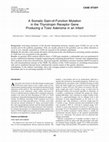Papers by Samuel Refetoff
JCI insight, Feb 20, 2024
BMC Medical Genetics, May 2, 2018
Frontiers in Endocrinology, Mar 31, 2021
Antioxidants & Redox Signaling, Apr 1, 2010
Journal of Clinical Investigation, Feb 1, 1991
Journal of Pediatric Endocrinology and Metabolism, 2013
Journal of Pediatric Endocrinology and Metabolism, 2008
Journal of Pediatric Endocrinology and Metabolism, 2015
JCI insight, Feb 20, 2024

Thyroid, Feb 1, 2009
Background: Activating mutations of the thyroid stimulating hormone receptor gene (TSHR) are rare... more Background: Activating mutations of the thyroid stimulating hormone receptor gene (TSHR) are rare in the neonate and in the pediatric population. They are usually present in the germline, and are either inherited or occur de novo. Somatic mutations in TSHR are unusual in the pediatric population. Methods: We describe a nine-month-old infant with thyrotoxicosis who harbored an activating somatic mutation in TSHR that was not present in the germline. Results: As genomic DNA analysis failed to show a TSHR gene mutation, a radioiodide scan was performed to reveal a unilateral localization of uptake suppressing the remaining thyroid tissue. Genomic and complementary DNA analyses of the active thyroid tissue, removed surgically, identified a missense mutation (D633Y) located in the sixth transmembrane domain of the TSHR. The absence of this TSHR mutation in circulating mononuclear cells and in unaffected thyroid tissue confirmed the somatic nature of this genetic alteration. Conclusions: To the authors' knowledge, this is the youngest patient to receive definitive treatment for hyperthyroidism due to an activating mutation of TSHR.
BMC Medical Genetics, May 2, 2018

Frontiers in Endocrinology, Mar 31, 2021
Resistance to thyroid hormone (RTH) is a clinical syndrome defined by impaired sensitivity to thy... more Resistance to thyroid hormone (RTH) is a clinical syndrome defined by impaired sensitivity to thyroid hormone (TH) and its more common form is caused by mutations in the thyroid hormone receptor beta (THRB) gene, termed RTHb. The characteristic biochemical profile is that of elevated serum TH levels in absence of thyrotropin suppression. Although most individuals are considered clinically euthyroid, there is variability in phenotypic manifestation among individuals harboring different THRB mutations and among tissue types in the same individual due in part to differential expression of the mutant TRb protein. As a result, management is tailored to the specific symptoms of TH excess or deprivation encountered in the affected individual as currently there is no available therapy to fully correct the TRb defect. This focused review aims to provide a concise update on RTHb, discuss less well recognized associations with other thyroid disorders, such as thyroid dysgenesis and autoimmune thyroid disease, and summarize existing evidence and controversies regarding the phenotypic variability of the syndrome. Review of management addresses goiter, attention deficit disorder and "foggy brain". Lastly, this work covers emerging areas of interest, such as the relevance of variants of unknown significance and novel data on the epigenetic effect resulting from intrauterine exposure to high TH levels and its transgenerational inheritance.
The Journal of Clinical Endocrinology and Metabolism, 2015
Antioxidants & Redox Signaling, Apr 1, 2010
Journal of Clinical Investigation, Feb 1, 1991








Uploads
Papers by Samuel Refetoff